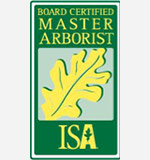Fall Tree Planting Tips and Suggestions
Spring is often regarded as the default season for all types of garden planting. Harsh winters and the lack of vegetation makes us excited for a new start, a garden, or to improve our landscape once the weather turns warmer.
While spring is often a great time of the year to plant a vegetable garden or flowers, planting for trees is different. The best time to plant a tree, especially in the Midwest states, varies depending on the tree type and climate, but fall is usually the best season.
Why Plant a Tree in the Fall?
The autumn season offers cooler temperatures that are still high enough to keep the soil warm, and also brings plenty of rainfall. This combination provides a great opportunity for newly planted trees to establish a root system before the ground freezes and the tree goes dormant.
When the air temperature is consistent and cooler than the soil, a tree is more likely to produce new root growth, without new top growth. These temps give the tree time to grow strong and deep roots, which are crucial when the tree is no longer dormant the following spring. A healthy root structure allows the tree to collect the necessary water and nutrients to grow and leaf before the scorching heat of the summer months stresses the tree.
Fall planting typically leads to healthy trees that are better equipped to handle the stress of heat and drought. Fall planting is also a great way to select your trees based on their autumn colors.
How Late in Fall Can I Plant a Tree?

The ideal time to plant your trees is about six weeks before hard frosts begin. The exact month to plant a tree in autumn depends on your location and weather, but typically between mid-August and mid-October is the perfect period. A good rule of thumb is that if the trees in your area still have leaves, then it is OK to plant new trees.
Not All Trees Should Be Planted During Fall Months
Trees and shrubs with a tendency to stress during Midwest summers are better planted in the spring months than in the fall. Avoid planting evergreens in the fall, as midwest winters are typically dry and this can have a negative impact. You should also avoid planting trees in locations that are exposed to cold weather, harsh winds, or in locations that cannot be watered. Follow up with the appropriate tree care, which is crucial for the successful establishment and growth of the tree, whether it’s planted in the spring or fall.
Right Tree Right Place
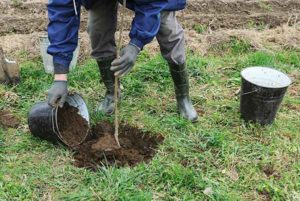
It is a great idea to call 811 before you begin digging to avoid any underground utility lines. This utility locator service can be a huge time saver and help prevent any utility issues from occurring down the road. It’s easy to get the necessary information quickly so you can dig without worry.
Tree Planting Procedure
The actual planting process is simple but requires a bit of work. Dig a large, bowl-shaped hole with sloped sides that is deepest in the middle. The depth should be about equal to the tree’s root ball and two to five times the width, depending on the variety of trees you are planting. Always learn the exact recommendations for planting each type of tree before you begin. Avoid digging too deep, as the tree will settle and negatively impact the root system.
After the hole is ready, set the tree in the center and then replace the dirt. Tamp the soil down gently. You want to remove air without causing compaction. The looser soil surrounding the root ball is essential to allow for fast root growth. Make sure the root collar remains just above the soil since this part of the trunk requires oxygen. You may need to add additional soil after watering if there is too much settling.
Where to Get Trees to Plant
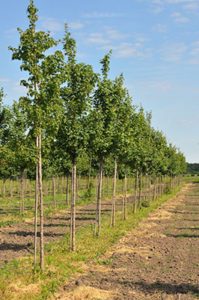
If you can’t find what you want locally, trees can be ordered online from numerous retailers and nonprofit organizations and some offer free or low-cost trees. The Arbor Day Foundation has a large selection of trees and will ship right to you. If you have the right conditions to plant them, you can choose from fast-growing trees, flowering trees, fruit trees, and evergreens.
Should I Fertilize a Newly Planted Tree?
Young trees are generally not fertilized at the time of planting as most soils supply an adequate amount of nutrients to promote growth. It’s best to wait one growing season before applying any added nutrients. The only exception is a root starter fertilizer, as establishing strong roots is more important in the early stages of growth than top growth.
Water Your Tree Correctly
Watering your new trees correctly during their first year is critical. They require more water than established trees, but be careful of overwatering them, which is just as dangerous as underwatering and a common watering mistake.
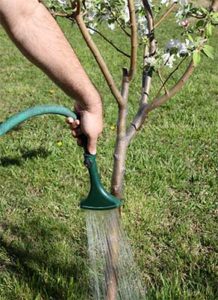
Watering can come from rainfall or a hose, so adjust the frequency of your watering schedule if your area is receiving a lot of rain. When watering with a hose it is best to turn the water on low and let the water thoroughly saturate the ground and soak into the soil over a 30 to 45-minute timeframe. This allows the water to reach deep into all the roots. Avoid letting the soil become soggy. Try to do your watering in the morning or evening to give the roots a chance to absorb the water before it evaporates.
Water the tree once a week until the ground freezes, even after the tree has lost its leaves. Continue this watering pattern once spring arrives and throughout summer. Soil doesn’t dry out quickly during the winter months, but it’s a good idea to occasionally check the moisture level to determine if you need to water if there hasn’t been much precipitation.
Create a Mulch Ring Around The Tree

Having mulch around a tree in the fall will help stabilize the temperature to decrease the possibility of freezing and thawing which often leads to frost heaving. Applying mulch is a fairly straightforward and simple process with no downsides. Aim for a layer that is around three inches deep and leave a three-inch gap around the tree trunk to prevent fungus growth. Mulch is available in a variety of materials, but organic mulches such as bark chips, sawdust, and even grass clippings offer more benefits.
Protect Your Trees From Wildlife
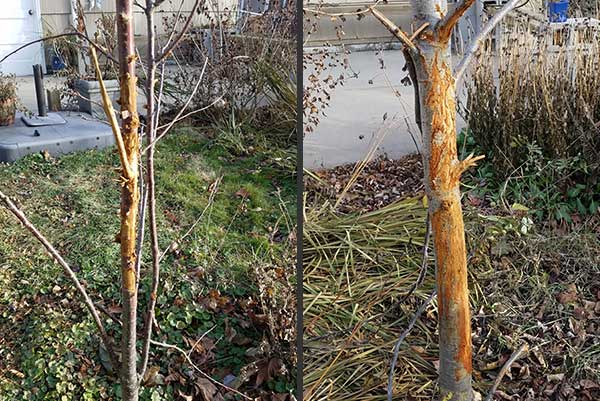
Damaged tree due to a buck rub on tree bark.
Image Source: Ask Extension
The first year after a tree is planted is crucial to its survival. Numerous creatures can harm a tree or even kill it with extensive damage. Buck rubs are especially dangerous as deer can easily kill newly planted trees. If you live in an area where deer and other wildlife might visit, then your trees are at risk. They naturally gravitate towards shrubs and trees as a source of shelter and food, so it’s important to employ effective, yet humane methods to keep animals away.
Fortunately, there are ways to help prevent tree damage from deer and other wildlife that are safe and poison-free so there is no risk to your family or unwanted creatures. The most effective methods are constructing physical barriers like individual tree guards and fencing, or employing a smell they find unpleasant as a deterrent. An easy smell to try is Irish Spring soap. The soap can simply be rubbed on the trunk of the tree. Or take a bar of the original scent soap and place it in a mesh or cloth bag. Hang the bag of soap at the height of an average deer so it reaches their nostrils. Place soap bags on or near your new trees and other plants you want to keep safe. One bar of soap is sufficient to protect an area of around 10 square feet.
Healthy trees last for many decades, so choose your varieties wisely and consider the features that you want. There are trees with beautifully changing leaf colors, shade trees, or ornamental trees with colorful and fragrant blossoms. Take the time to research the trees best suited for your climate and available space. Remember to follow planting instructions carefully and follow that with regular maintenance to encourage healthy growth. A yard filled with trees provides gorgeous scenery and offers many benefits from preventing soil erosion to lowered energy bills to improved air quality. This fall is the perfect time to select your favorite trees and start planting.
Contact a Professional for Tree Planting Service
We would love to help you with fall tree planting and proper tree care. Contact us today for a Free Estimate and let us help you with your fall tree planting needs by a RYAN tree care expert!







